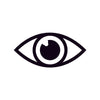WHAT IS MYOPIA?
Do you face difficulty reading distant signboards? Are you unable to make out who is waving at you across the street? Is it impossible for you to see what’s written on the blackboard from the last row of seats? If you're facing these common problems, you might benefit from a myopia diagnosis and treatment.
According to studies, approximately 186 million people are currently affected by myopia globally. This figure is estimated to increase to about 200 million by 2050 (2,5). Nearsightedness is a particularly prevalent condition in young people and children and usually starts between 6 and 14 (4). Early myopia treatment will help decrease eye strain in children during their learning years and prevent future sight problems.
Taking a closer look at myopia
Myopia or nearsightedness is a common eye condition in which a person is unable to see distant objects clearly or faces difficulty while reading words from far away distances. Normally, the eye’s lens and cornea focus light into an image on the retina. In nearsightedness, this light is focused in front of the retina, causing a blurry image or vision while looking at distant objects and the need to squint while looking at faraway objects (3). Myopia treatments such as glasses and contact lenses focus on aiding people to see faraway objects.
The causes of myopia
There are numerous causes of myopia. The size and shape of the eyeball, the cornea’s focusing power and the eye’s lens are all contributing factors.
Nearsightedness is sometimes an anatomical issue resulting from a long eyeball that prevents the lights from focusing directly on your retina. Myopia can also be caused by an eye lens that is too convex or curved. According to scientists, nearsightedness might also be a genetic condition that is passed down to children from their parents (1). Some other conditions include staying indoors for extended time periods and visual stress from using computer screens or excessive reading. Other causes also include poor metabolism, poor light, poor diet and poor posture.
Common symptoms of myopia
A nearsighted test can help an optometrist evaluate whether you are myopic and guide you on how to treat your nearsightedness. Some common symptoms of myopia that you can keep a check on include (3):
- Blurry vision while looking at distant objects
- The need to squint or partially close your eyelids to see clearly
- Eyestrain and headaches
- Excessive blinking
If you are struggling with any of these symptoms, it’s best to book an eye test to prevent unnecessary eyestrain and get an expert myopia diagnosis as soon as possible.


